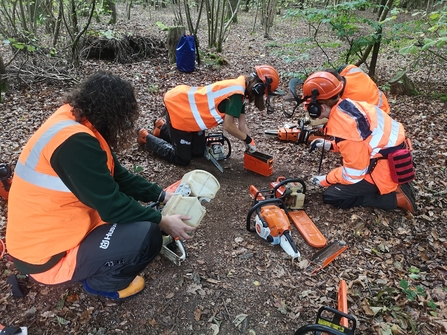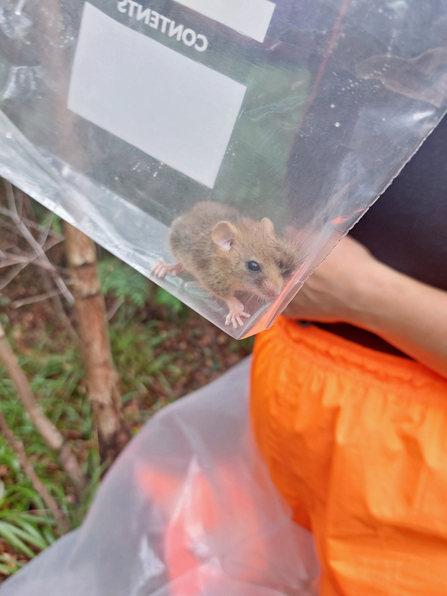It has been a bit of a chaotic, mad old month for me! All of us trainees have been preparing for our chainsaw cross-cutting and maintenance exam for around a month. Our chainsaw tickets will allow us to perform useful tree management work over the upcoming autumn and winter months when weather may worsen and cause tree casualties out on the nature reserves.
Chainsaws, critters and reigning chaos
Sophie (right) and Lizzy (left)

Trainees and chainsaws by Joe Edwards
We each got kitted out in chainsaw trousers, boots and gloves along with our existing helmets with in-built ear protection that were given to us at the start of the course. The boots and gloves have special reinforced areas and the trousers have protection in the form of densely woven Kevlar fibres that will block and stop the chainsaw if contact is made. We started off with informal training with Andy B in which we learnt about the pre-start checks and had a practice cutting some small logs in our new chainsaw gear. Then we all had our training, which was spread out over two days with an instructor who taught us everything from health and safety to re-tensioning our chains.
Then came a crazy few weeks of revising all the knowledge of chainsaw maintenance and practising my cutting skills out with Andy and the other trainees. I needed to wrap my head around tension and compression of the timber; when timber is under strain it can start to fall and trap the saw. By cutting the compression side first by a third of the width, then cutting the tension side the rest of the way, it makes for a smoother cut and prevents the saw getting trapped. We needed to know how to perform the tension and compression cuts along with upper, lower and bore cuts (which are used when the underside of the timber is resting on the ground and cannot be accessed). We helped each other out and I’m so grateful to have the support of my fellow trainees; I think on the big day of our assessment we all trauma bonded with the shared stress! I am happy to report we all passed with flying colours and we can all collectively breathe a sigh of relief (as can Andy B) until our felling assessment in a few months’ time.

Dormouse monitoring by Sophie Grove
An exciting day for me and fellow trainee Sam was the opportunity to go dormouse nest box checking in the Wyre Forest. We were accompanying Andy B and ranger Phil Rudlin (from Forestry England and who has been surveying dormice for 20 years) who both have licences required by law to handle dormice and check their nest boxes. Hazel dormice are protected in the UK, their conservation status is vulnerable and they're in serious decline.
The placement of dormouse boxes allows monitoring of the population density in this site. Dormice will use them to rest and raise their young during the spring and summer months, readying themselves for hibernation in the autumn by gorging themselves on berries and, of course, hazelnuts! During the winter they hibernate at ground level including under leaf litter, which is why it's important to keep to paths and keep dogs on lead all year round, not just in bird breeding season.
I learnt what goes into dormouse monitoring: first a careful quiet approach to the nest box,. The hole is stoppered up with a piece of folded fabric and the lid is opened a small amount to have a peek in (and ensure you haven’t opened a box full of hornets). If there is a dormouse nest in the box, the box is placed in a plastic bag to safely open to prevent escapees. Information is recorded from each dormouse including age, sex and weight (the dormouse is placed in a bag and carefully weighed using a clip attached to portable scales) and the individual is microchipped so it may be monitored and its movement understood in the future if it is recaptured. We were lucky enough to find three dormice and two pipistrelle bats also camping out, which was a delight. All in all it has been a very fulfilling and busy month and I’m excited to see what October has in store for me.

